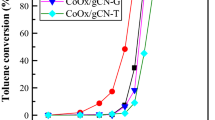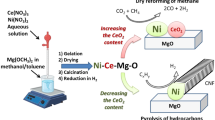Abstract
The layered structure oxide Ca3Co4O9 particle was synthesized by two routes of citrate sol–gel method. The structure, morphology and surface property of Ca3Co4O9 was characterized by XRD, SEM and XPS, respectively. The catalytic activity of Ca3Co4O9 for methane combustion was tested in a fixed bed quartz tubular microreactor. The catalysis results reveal that the catalytic activity is sensitive to the texture of Ca3Co4O9 by different route. TG measures confirm that the small particle size of Ca3Co4O9 favors the oxygen transformation on the surface, which can be ascribed the random distribution of the crystal axes in irregular Ca3Co4O9 particle.
Similar content being viewed by others
Explore related subjects
Discover the latest articles, news and stories from top researchers in related subjects.Avoid common mistakes on your manuscript.
1 Introduction
Recently, the misfit layered cobalt oxides Ca3Co4O9 has received considerable attention due to its excellent thermoelectric property [1, 2]. Many efforts have been devoted to fabrication of textured Ca3Co4O9 ceramics or single crystals of Ca3Co4O9 and their thermoelectric properties [3–6]. On the other hand, it is reported that the Ca3Co4O9 shows large range oxygen content variation depending on the temperature and partial pressure of oxygen [3, 7]. However, the property of oxygen nonstoichiometry in the misfit-layered calcium cobalt oxides has not paid more attention to.
Catalytic oxidation of methane over metal oxides catalysts is an environmental friendly reaction because of a relatively low CO2 emission for the same amount of energy production and lower NOx formation in energy production. Some investigations indicate that the lattice oxygen is likely to be involved in the catalytic oxidation over cobalt oxide [8], and the reaction follows the Mars–Van Krevelen redox mechanism [9]. In this work, we prepared polycrystalline Ca3Co4O9 material by two routes of citrate gel method and evaluated catalytic property of as-prepared Ca3Co4O9 for methane oxidation reaction, with the aim to investigate the catalytic activity of oxygen vacancy and effect of particle texture on the catalytic property.
2 Experimental
2.1 Preparation
The Ca3Co4O9 was synthesized by two routes of citrate gel method.
Ca3Co4O9-A: An aqueous solution containing calcium and cobalt nitrate (Ca/Co molar ratio = 0.75), and citric acid (citric acid/(Ca + Co) = 1.3) was gradually heated to 80 °C resulting in the formation of a gel. The gel was kept at this temperature for 4 h with stirring and dried at 120 °C for 12 h. The dried was burned using anhydrous ethanol as the igniter. The obtained ash was pulverized and then calcined at 900 °C for 10 h.
Ca3Co4O9-B: In this method, a dispersant of polyethylene glycol (PEG) 400 (2% volume ratio) was added in the mixture solution of metal ions and citric acid (similar to Process A). The solution was heated at 80 °C to obtain the gel. The gel was dried at 120 °C for 12 h and then heat treated in the air at 500 °C for 2 h. Finally, the ash was calcined at 900 °C for 9 h.
2.2 Characterization
The crystalline structure of the catalysts was characterized by X-ray diffraction (XRD) using Ni-filtered Cu Kα radiation (λ = 1.5406Å) (Rigaku D/Max-γA, Japan). The morphology of the particles was examined using field emission scanning electron microscopy (JEOL 6500F). X-ray photoelectron spectroscopy (XPS) measurements were performed with Mg Kα (1,253.6 eV) as the exciting radiation (ESCALAB Mark II, VG). Thermogravimetric analyses (TGA) were performed for the as-air-synthesized sample in a nitrogen stream at a heating rate of 10 °C min−1 (STA449C, Netzsch).
2.3 Catalysis test
Catalytic tests were carried out in a fixed bed reactor constituted of a quartz tube with an inner diameter of 4 mm at the atmospheric pressure. The feed consisted of a mixture of 2 mol% CH4, 20 mol% O2 and N2 balance, with total gas hourly space velocity (GHSV) of 76,000 h−1. The effluent composition was determined using on-line gas chromatography (Shimadzu, GC-14C) using a thermal conductivity detector (TCD) equipped with two columns, in which N2, O2 and CH4 were separated by 5 A molecular sieve column and CO2, C2H4 and C2H6 by GDX-502 column.
3 Results and discussion
Figure 1 shows the X-ray diffraction (XRD) patterns of two as-prepared Ca3Co4O9 samples. The XRD patterns show same polycrystalline misfit layered cobalt oxides Ca3Co4O9 structure (JCPDS File Card No. 23-0110) mainly. There was no evident diffraction peak referring to Ca3Co2O6, or CaO and CoO. However, a small amount of Ca2Co2O5 phase (JCPDS File Card No. 37-0668) was found in two of samples. The Ca2Co2O5 is reported to exhibit a considerably same misfit layered crystal structure with Ca3Co4O9 possessing 25% Ca site vacancy [10]. Thus, the most diffraction peaks of the two phases are overlapped. The c-lattice parameter, computed using d-spacing values of (00l) reflections, was found to be 10.83 Å, which is in agreement with the reported value [1].
Figure 2 shows the SEM micrographs of the Ca3Co4O9-A and Ca3Co4O9-B particles. It is obvious that the dispersant and heat treatment condition has distinct effects on the crystal growth though are plate-like particles observed at higher magnification micrograph ((b) and (d)). Ca3Co4O9-A sample is irregular in size distribution and shape of particles. In comparison, the Ca3Co4O9-B sample is homogeneous and high textured.
Figure 3 presents CH4 conversion plots obtained over two Ca3Co4O9 samples. It can be seen that two samples exhibited a remarkable difference in methane oxidation reaction at the same condition. Ca3Co4O9-A is more active than Ca3Co4O9-B, the light-off temperature was about 500 °C, T10 and T90 were 575, 725 °C respectively. In contrast, the light-off temperature was about 700 °C in Ca3Co4O9-B.
It is well accepted that gas-phase oxygen molecules are activated through an interaction with the surface of the catalyst for methane deep oxidation over metal oxides [11]. At first, the surface oxygen species on Ca3Co4O9 was studied by XPS O1 s spectrum. As shown in Fig. 4, two samples reveal almost same surface oxygen property; a good curve fitting is obtained with three resolved O1s XPS peaks. The first peak with low binding energy (~529.1 eV) corresponded to CoO2 layer on the surface. The second peak at binding energy (~531.3 eV) is usually ascribed to CaO layer species on the surface [12]. The minimal peak at binding energy about 533.4 eV may be assigned to adsorbed water molecules from humidity. Therefore, it can be concluded that the oxygen species on Ca3Co4O9 surface don’t cause the difference of catalytic oxidation of methane at this condition.
Secondly, we investigated the oxygen transformation on the surface of Ca3Co4O9 by thermoanalysis measure of the as-synthesized Ca3Co4O9 in a flowing nitrogen stream, as shown in Fig. 5. The overall weight loss observed in two samples can be divided into three processes from room temperature to 1,000 °C. The first weight loss before 500 °C could be assigned to desorption of the surface adsorbed oxygen species, which is adsorbed in the structure defects (oxygen vacancies). It is notable that at about 510 °C there is a small but visible change in the slope of the TG curve. The same phenomenon has been observed by Y. Morita and is suggested as a possible phase transition point [13]. The second weight loss between 500 and 850 °C can be accounted for loss of surface lattice oxygen resulting in oxygen vacancy formation. The third weight loss possessing two successive weight losses between 850 and 1,000 °C is assigned to the decomposition of Ca3Co4O9. Although the Ca3Co4O9 phase transforms to Ca3Co2O6 phase at 950 °C in air atmosphere [14], it is predictable that the decomposition temperature of Ca3Co4O9 will move towards lower temperature in nitrogen atmosphere. Therefore, Ca3Co4O9 was likely to decompose to Ca3Co2O6 at 850 °C firstly, and then, Ca3Co2O6 decomposed to CaO and CoO finally.
However, two samples gave different dynamic behavior of oxygen desorption during N2 annealing. The weight loss in Ca3Co4O9-A is bigger than that in Ca3Co4O9-B at the same condition suggesting that desorption of oxygen species in Ca3Co4O9-A is easy. Ca3Co4O9 has a layered structure in which two different kinds of Co–O layers alternate in the direction of the c-axis. In one of the layers, Co atom is in an octahedral configuration and the octahedral are edge-shared (CoO2 layers). In the other layers, Ca, Co and O form triple rock-salt (Ca2CoO3+δ) layers [5]. M. Karppinen et al. [13, 15] investigated the oxygen nonstoichiometry of the Ca3Co4O9 and supposed that all vacancies are in the CoO layer of the insulating Ca2CoO3 block. In this block, the CoO layer is sandwiched in between two CaO layers. As a result, the oxygen exchange between gas and crystal lattice in small particle of Ca3Co4O9-A is easier than that of Ca3Co4O9-B by the random distribution of the crystal axes, as given by
4 Conclusions
Two layered structure oxide Ca3Co4O9 particles were successfully synthesized by different routes of citrate gel method. XRD and XPS confirmed there was no obvious difference in structure and surface oxygen property for two samples. The catalytic tests revealed that two Ca3Co4O9 particles exhibit distinct activity for combustion of methane. Based on the SEM results and TGA data, we suppose that small irregular Ca3Co4O9 particle with random distribution of the crystal axes favors the oxygen transformation on the surface and catalytic activity.
References
Masset AC, Michel C, Maignan A, Hervieu M, Toulemonde O, Studer F, Raveau B (2000) Phys Rev B 62:166–175
Matsubara I, Funahashi R, Takeuchi T, Sodeoka S (2001) J Appl Phys 90:462–465
Masuda Y, Nagahama D, Itahara H, Tani T, Seo WS, Koumoto K (2003) J Mater Chem 13:1094–1099
Tani T, Itahara H, Xia CT, Sugiyama J (2003) J Mater Chem 13:1865–1867
Zhang Y, Zhang J, Lu Q (2007) Ceram Int 33:1305–1308
Bhattacharya S, Aswal DK, Singh A, Thinaharan C, Kulkarni N, Gupta SK, Yakhmi JV (2005) J Cryst Growth 277:246–251
Shimoyama J, Horii S, Otzschi K, Sano M, Kishio K (2003) Jpn J Appl Phys 42:L194–L197
Arnone S, Bagnasco G, Busca G, Lisi L, Russo G, Turco M (1998) Stud Surf Sci Catal 119:65–70
Bahlawane N (2006) Appl Catal B 67:168–176
Vidyasagar K, Gopalakrishnan J, Rao CNR (1984) Inorg Chem 23:1206–1210
Sokolovskii VD (1990) Catal Rev 32:1–49
Wakisaka Y, Hirata S, Mizokawa T, Suzuki Y, Miyazaki Y, Kajitani T (2008) Phys Rev B 78:235107
Morita Y, Poulsen J, Sakai K, Motohashi T, Fujii T, Terasaki I, Yamauchi H, Karppinen M (2004) J Solid State Chem 177:3149–3155
Zhang Y, Zhang J, Lu Q, Zhang Q (2006) Mater Lett 60:2443–2446
Karppinen M, Fjellvåg H, Konno T, Morita Y, Motohashi T, Yamauchi H (2004) Chem Mater 16:2790–2793
Acknowledgments
The authors acknowledge support from the Nature Science Foundation of the Department of Education of Anhui (KJ2009A023Z) and the Open Fund of Anhui Key Laboratory of Controllable Chemistry Reaction and Material Chemical Engineering.
Author information
Authors and Affiliations
Corresponding author
Rights and permissions
About this article
Cite this article
Feng, S., Yang, W. Effect of the preparation method on the catalytic performance of Ca3Co4O9 for methane oxidation. J Sol-Gel Sci Technol 58, 330–333 (2011). https://doi.org/10.1007/s10971-010-2396-1
Received:
Accepted:
Published:
Issue Date:
DOI: https://doi.org/10.1007/s10971-010-2396-1









